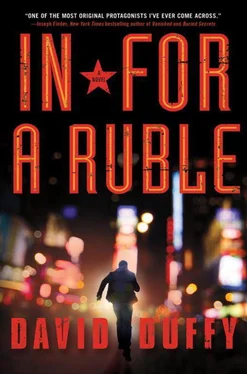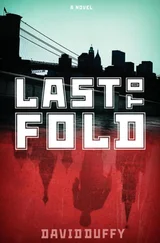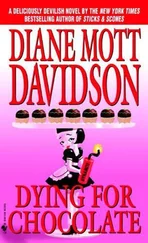After Foos sold his company, he gave Leitz some of his fortune to invest along with a chunk of the assets of the foundation he endowed and runs—STOP, short for “Stop Terrorizing Our Privacy.” I’d read Leitz required a minimum investment of $5 million and regularly racked up returns north of 30 percent a year, after fees of 3 percent of assets under management and the first 30 percent of profits earned. Fees were another big thing about him.
When I asked Foos about that, I got the usual, “Leitz does okay.”
I gave up. I checked STOP’s records, which I’m entitled to do since I’m the other member of the board, although Foos neglects to send me financial reports—or any other reports for that matter. I don’t know how much of STOP’s money Leitz invested, since the assets could be spread among multiple managers. STOP’s most recent tax return, which I downloaded from the Internet, showed total assets of $208 million. It started with $50 million five years ago. The markets had tanked in the interim. Leitz indeed appeared to be doing okay.
On our way uptown, I again pressed Foos about his friend.
“What happened to the first Mrs. Leitz?”
“Bad scene.”
“You know her?”
“A little.”
“How bad?”
“The worst.”
“And wife number two?”
“Jenny. She’s cute. Smart too.”
“Bad? Cute? Smart? Care to add a little color?”
“Not my business.”
He looked out the window, and we rode in silence the rest of the way. In the twenty years I’d spent with the KGB, I’d never heard of anyone standing up against a full-bore Cheka interrogation. Given the chance, Foos could’ve been the first.
Someone had left the Post on the cab’s backseat. NEW BIDDERS EXPECTED IN TV WAR, the headline read. The story cited Wall Street sources, all unnamed, stating that several consortia, involving everyone from Warren Buffet to Bill Gates to a couple of Chinese billionaires, were in the process of putting together offers to rival Leitz’s. Wall Street was in full M&A—merger and acquisition—frenzy. The fees alone were expected to run into the hundreds of millions. The ensuing battle could last months.
Normally, I’m as caught up as the next guy in stories like this one, events that promise change and upheaval in the landscape—economic, social and cultural—of my adopted country. My natural curiosity (a character trait I’ve never tried hard to tame) would be working overtime at the prospect of meeting the man who’d set it in motion. But today as I read the story, noted the names, registered the humongous amounts of cash involved, I felt no spark. Whatever Leitz wanted didn’t matter much. He might occupy my time, perhaps a bit of my attention, for a day, a week or a month, but he and his bidding war wouldn’t do a damned thing to alter the fucked-up mess that had become my life.
At the corner of Madison and Sixty-second, Foos paid the driver. We walked half a block east. The morning was bright and crisp, not too cold for the second week of January. The remnants of a New Year’s storm lined the sidewalks, mostly frozen slush now, covered with a coat of city grime, nothing compared with the three feet of black encrusted snow I’d left in Moscow back before Christmas.
Leitz’s spread was almost precisely midblock, on the north side of the street. A handsome six-story brick house at the center, with cream-colored trim. Half the façade was flat-fronted, half formed a graceful bay, as if the architect had tried to make one house look like two. Avoiding ostentation perhaps. The rest of the expanded mansion comprised two traditional New York brownstones on either side. Foos pushed a brass button by the black door, and a Filipina answered. She smiled hello, ushered us inside, and offered to take our coats.
We stood in a stone-floored, chandeliered entrance hall that occupied the full width and half the depth of the double brick house. An elliptical staircase swirled upward at the center. The hall was hung as a portrait gallery—nineteenth century European, maybe a few American, paintings covered three of four walls. One picture caught my eye, a handsome, bearded man in his late thirties. I went over for a closer look. It was what I thought—a self-portrait by Ilya Repin, probably painted in the 1880s. I’d seen one like it at the Tretyakov in Moscow. The Met has a couple of Repin’s works, but they’re hard to find outside Russia. Leitz was becoming a little more interesting.
Foos came up beside me. “Nice picture.”
“We’ve got some good painters. He’s one.”
“Not surprised. Leitz knows his stuff.”
“Please, gentlemen, upstairs. Mr. Sebastian waits.” The maid stood by the staircase pointing. We followed her direction.
Carpeted wood steps, painted balusters and a smooth mahogany banister climbed all six stories. On the second floor, two sets of double doors opened off the central hall into a high-ceilinged, paneled room in the front. I got off to take a look. It ran the width of the brick house—six windows—with a marble fireplace at each end. The furniture was a mixture of English and French antiques. A Picasso cubist still life hung over one fireplace in refined revolutionary conversation with a Braque over the other. Matisse, Cézanne and Manet graced the other walls.
“One more flight, boys, the inner sanctum,” a loud voice called, and I returned to the stairs to see a large head of curly reddish-blond hair flopping over the railing from above. Foos was already halfway up. I followed, regretting not being able to spend more time with the paintings in the drawing room. But I didn’t know what was to come.
On the third floor, off the stairs, I came face-to-face with a huge Rothko color field—blue and red and purple. The closeness and intensity took me aback, until I realized that beside me was another one of the same size—yellow, orange, and red. I turned slowly around the hall. There were four of them, one for each wall, and the impact was overwhelming, a whirling cocoon of color, too close and too bright, and much too deep, to take in all at once.
Foos passed through unaffected. He’d been here before. I spun in my spot, trying to establish myself and get some perspective. It wasn’t possible. Three-dimensional hypnosis. I had to fight to break the spell and pull my eyes from the color, infinite in its intensity. I turned to the red-haired man in the doorway.
He was smiling. “People say it’s over the top, but I like a real kick in the ass.”
“You got that, all right,” I said, extending my hand, head still spinning
His paw enveloped mine in a tight grip. “Sebastian Leitz. Come in.”
This room was as big as the one on the floor below, also paneled, but in blond wood with clean, contemporary lines. Fireplaces at both ends again, but these had simple, limestone mantels with no frills or decoration. Wood fires burned in both. The paintings were contemporary too—Franz Kline held down one end, Robert Motherwell the other, two more heavyweights thrashing out their own generation of abstraction. But it was the top right corner, above the desk, that caught my eye. A smallish canvas, compared with the others, eighteen inches by three feet, highlighted by a single spot. A collection of blue, yellow, red, green, and brown rectangles floating on a white background.
I remembered the painting—and where I’d first seen it. Kasimir Malevich, Suprematist Composition, painted in 1916. I’d gone to look at it at Sotheby’s a few years ago, right before it sold for $80 million. I raised an eyebrow at the buyer. He nodded.
“Not many people get that. But you’re Russian, right? Not Black Square, but the best I could do.”
“You did well. It’s… You know as well as I do—words are hard to come by.”
Читать дальше












